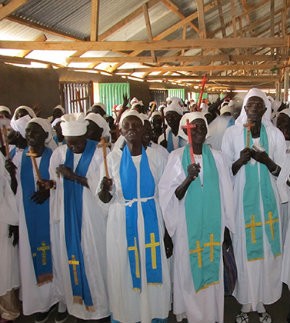Songs of exile and faith: Dinka Christians in South Sudan

At first glance the wooden benches in the front rows of St. Andrew’s Episcopal Cathedral in Bor, South Sudan, are simple and unremarkable. But the black letters painted on the side of each bench tell a story: ECS Zone 1 Parish. ECS is the Episcopal Church of the Sudan, and Zone 1 refers to an area of Kakuma, the refugee camp in northwestern Kenya that became home for tens of thousands of southern Sudanese during the country’s civil war (1983–2005).
The pews testify to a simple fact: the Dinka church is a church of exile. When the civil war began there were only five Dinka congregations stretched along 150 miles of the Nile’s east bank. They were all that remained of the British Anglican missionary presence among the Dinka in the early and mid-1900s. Today that same 150-mile stretch is home to more than 300 Anglican congregations (and a handful of others in other denominations), not to mention innumerable preaching centers in cattle camps along the Nile. There are two dioceses in the area and plans to create more. Virtually every one of the villages on the roads leading out of Bor has a church—often a mud-and-thatch building.
The Christianity of today’s Dinka emerged out of the sorrow and deprivation of refugee life, a time of despair that led many refugees to turn to the church for support, nurture and growth. It’s no accident that the wooden church pews came back with the refugees. Today the cathedral in Bor is a center of South Sudanese life. On Sunday mornings the building pulses and shakes with the energy of up to 1,500 worshipers. The same is true in the churches scattered throughout the region.





